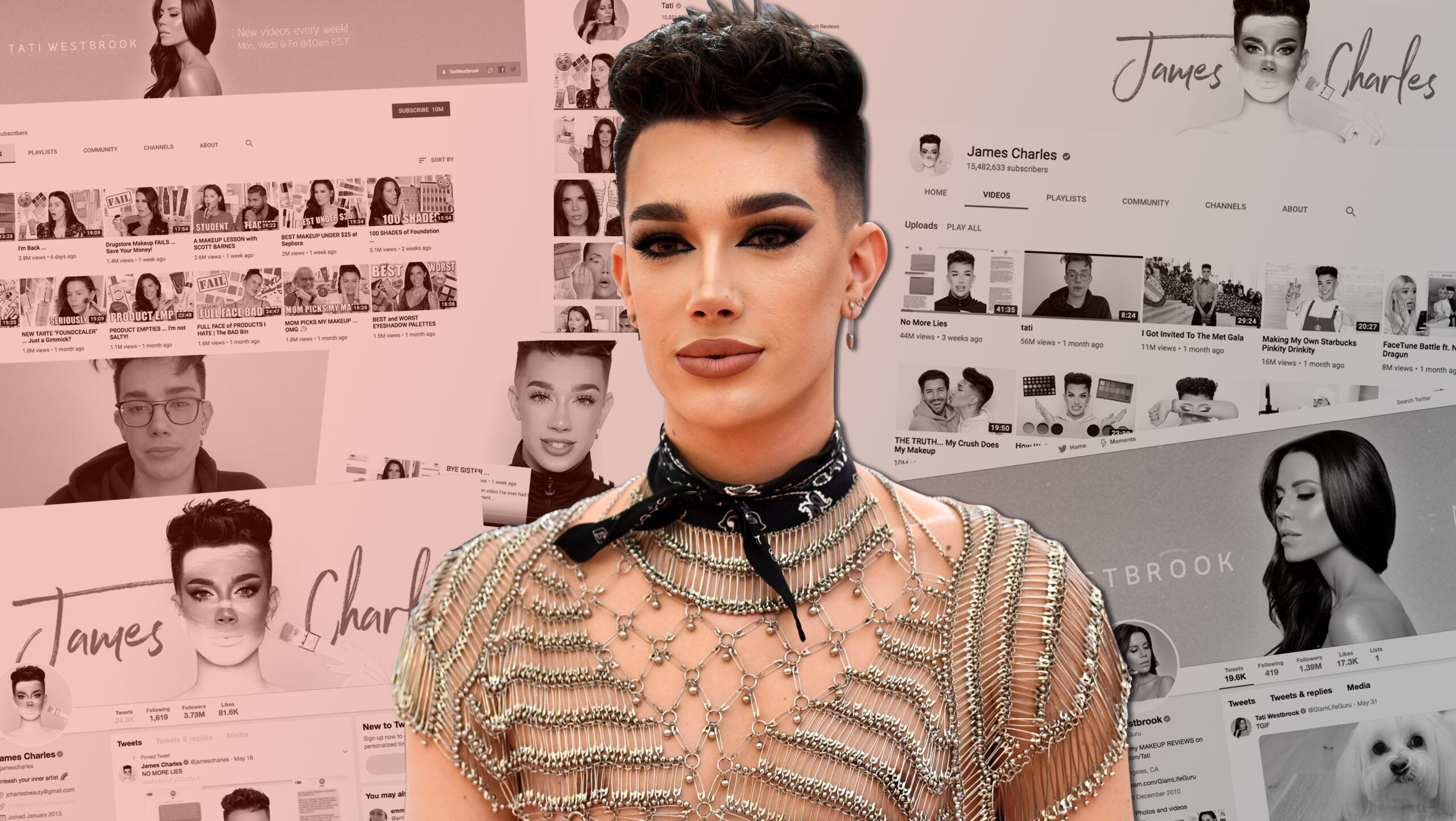Last month, YouTube celebrity beauty vlogger Tati Westbrook released a 40-minute video cataloging the demise of her friendship with fellow YouTuber James Charles. In the (since-deleted) video, viewed more than 30 million times, Westbrook alleges the gay 19-year-old Charles attempts to abuse his celebrity status to prey on straight men.
Charles’ multi-million subscriber count plummeted, prompting him to depart from his usual brand of tutorials and product reviews to share a tearful apology in response (weeks later he fired back with a critical video of his own). Within days, Westbrook and hundreds of online commenters named him aggressive, predatory and exploitative.
The narrative has changed several times since the Tati and James drama first erupted. But even as the allegations of abuse and betrayal shifted, one theme endured — casting Charles as a gay person “tricking” or “trapping” straight men by using his clout to manipulate, seduce and make them question their heterosexuality. In this figuration, Charles is not just guilty of abusing his power and celebrity, but of harbouring a perverse fascination with forbidden goods. Here, Charles is not just a gay guy with a specific taste, but a trespasser into heterosexual territory with potential to ensnare unsuspecting straight men — a moral threat, first and foremost.
The James Charles drama is a strange and intoxicating episode. But it also provides a window into a larger cultural conversation (happening both as text and subtext) around the relationships that exist between gay and straight men, and how those relationships morph in the public eye. What does it mean when gay men desire straight partners, and what do straight men gain from pursuing queer or closeted people? And more importantly, how are these relationships impacted by imbalances of power?
It’s true that there is a long-running current of queer male fascination with straight men and straight culture, evidenced in everything from “masc only” Grindr bios to the success of gay-for-pay porn studios like Sean Cody, Corbin Fisher, Fraternity X and others.
“What does it mean when gay men desire straight partners, and what do straight men gain from pursuing queer or closeted people?”
But outside of sexual fantasy, there is a certain imaginary romance to the pursuit of straight men — especially so for gay men at the end of their adolescence and the cusp of young adulthood, when a rich adult gay life is still beyond reach. Straight men populate the cast of characters in everyday life — the guys on the football or hockey team, authority figures, teachers, friends’ older brothers. It’s understandable that these men are the focal points of adolescent fantasies, and that the idea of “turning” straight men gay holds a certain allure. This remains true even now, at a time when young gay men have greater access to LGBTQ2 communities than ever before (a difference that is impressive only in a relative sense; no matter the many small recent advances, it is still difficult to live a vibrant queer life as a young person).
As well, these straight men are, in a way, models of masculinity. Thirsting for them is a symptom of our wider cultural obsession with cisgender maleness as an object of ultimate desire. Masculine men are privileged in virtually every space in society. Desire is not immune, no matter how progressive we try to be in confronting it. As trans theorist Andrea Long Chu writes, while it goes without saying that desire is political, it is also true that desire often fails to conform to our politics. And beyond and among this is the intoxicating pull of being special, the romance of exemption and exception. There’s a kind of erotic draw to the notion of forbidden desire and star-crossed lovers, of being wanted and adored fully against someone’s nature, of being the kind of guy that anyone, even a straight guy, would want.
But what’s missing from this conversation is a recognition of the fact that sex between straight men and gay men (and between straight men and trans people) happens all the time. Anyone with a Grindr account is familiar with the existence of straight men, guys with wives and girlfriends and faceless app profiles who seek out gay and trans partners for surreptitious trysts. In fact, the pattern goes beyond apps and one-off liaisons. In one iconic interview for the 1993 documentary Octavia Saint Laurent: Queen of the Underground, transgender ballroom legend Octavia St Laurent described straight male culture as being dictated by men in places of authority who secure their status by invoking violence against gay and trans people even as they lust after them in secret.
“Our whole fucking world is being run by perverted, undercover fags that run around talking about how ‘straight’ they are,” St Laurent said. “You got big-time celebrities that go around in their cars, picking up transvestites, having sex with them, and then getting on national TV making fun of them. Everything you do in life is like a boomerang: when you throw it, it eventually comes back.”
“Thirsting for [straight men] is a symptom of our wider cultural obsession with cisgender maleness as an object of ultimate desire.”
How do we explain the enduring prevalence of secret relationships between gay and straight men? The answer may have less to do with gay men’s tastes and more to do with male heterosexuality in general. Feminist theorist Catherine McKinnon once argued that male sexuality, particularly heterosexuality, is an inherently exploitative dynamic; as she argues, men are encouraged to view sex as domination, invasion or exploitation of the vulnerable. With this in mind, it’s easier to make sense of the other half of the equation. If some gay men are attracted to the allure of forbidden hypermasculinity, then some straight men are also attracted to the opportunity for sexual domination of a vulnerable partner — someone they can toss aside, keep secret or dismiss as a “fag” when they’re done with them. This can especially be true when the dynamic is between an older straight man and a younger gay man. After all, for those men whose positions of authority are inscribed by a performance of heteronormative masculinity — religious leaders, politicians, businessmen — who is more vulnerable than a queer youth whose silence can be bought or coerced?
Of course, not all relationships between straight men and queer people are violent. They are occasionally fulfilling, intimate and transformative. Relationships of this kind happen all the time, whether or not they’re publicly acknowledged by either party. There are even cases of them lasting several years, sometimes on-and-off as the straight partner attempts to make sense of their sexuality and reconcile the relationship with their heterosexual role. In other cases, the relationship is about something else entirely, what might be called “trade” — a casual and often transactional partnership between a gay person and a masculine straight man who trades affection for money or support. Here, there is another power imbalance at play that is not easily captured by a simple emphasis on straight privilege or homophobia. This is the casual and potential violence carried within the power of class, a violence that is heightened when class, as it so often does, runs alongside race. Indeed, the two mutually enforce one another to establish white wealth, and the disenfranchisement of people of colour.
On some level, there are elements of this dynamic in the exchanges between Charles and the straight men he pursues. None of this, if Westbrook’s allegations are accurate, excuses Charles’ behaviour. We can all agree that it is wrong to pursue someone uninterested in our advances and that it’s gross and abusive to use one’s power and status to apply pressure in intimate situations. These actions are elements of rape culture, and they are violent no matter who enacts them.
Yet, all the same, it’s hard to read the tenor of discourse around the James Charles debacle as solely concerned with the possibility of exploitation. Lurking beneath the surface of these allegations is another fear altogether — not of sexual violence, but of sexual contagion. It is the fear of queer possibility. Because, even as straight men occupy a position of curious sexual fascination in gay male culture, the spectre of gay sexuality has haunted the heterosexual imagination for generations as a distinctly predatory figure.
This conflation of queer sexuality with social and political infiltration contributed to the purges of Canadian LGBTQ2S civil servants in the 1950s, and the RCMP investigations into thousands of teachers, civil servants and trade unionists in the 1960s on the basis of their suspected “moral defects.” Powerful institutions like the Catholic Church take up this same narrative to blame “the homosexual agenda” for their own abuses of vulnerable children and youth. American lawmakers were so concerned about the threat posed by homosexuality that they ushered in a wave of anti-LGBTQ2S arrests and endorsed conversion therapies, the legacy of which continues today. In so much of modern institutional memory, “gay” has been synonymous with “threat,” or “infiltration.” From Cold War propaganda to contemporary conservative punditry, in circles both secular and religious, queer sexuality is figured as actively seeking to seize upon the vulnerable members of “normal” society, ready to entrap them at any moment and claim them for their perverse lifestyle.
“Lurking beneath the surface of these allegations is another fear altogether — not of sexual violence, but of sexual contagion. It is the fear of queer possibility.”
This is, supposedly, the gay agenda. And Westbrook has offered evidence of it in action. No wonder the reaction has been so intense and vitriolic. Even after publishing his response video and earning apologies from Westbrook and others, Charles’ brand has been irreparably damaged by this incident in a way that has far outweighed the backlash or consequences of his flippant anti-Black racism and the kind of routinized cultural appropriation of gay Black vernacular common to beauty YouTubers. It is difficult to reconcile a critical view of these events with Charles’ unworthiness of martyrdom (he’s not exactly the most conscientious representative of the queer community). I have no interest in redeeming Charles, or giving him more opportunities to use his celebrity status to secure uncertain consent from men he has no business pursuing. Still, it is hard to watch this spectacle unfold without feeling the nagging sensation of a familiar narrative being imposed — the drawing of lines, the casting of characters, the defining of roles. And in this narrative, other questions of power and abuse are permitted to go unanswered.
When we see gay sexuality as always and already predatory, and heterosexuality as an endangered “normal” space in need of protection, we abandon the critical tools that allow us to intervene in cases of male violence against women, queers and trans people. We cannot simply leave the conversation at a critique of Charles without placing him in the wider context of imbalanced power and male sexuality that renders him both subject and object. In this way, the episodic rise, fall and return of Charles reveals the moral failures of male sexuality and the power of narratives to shape our perception of abuse. Charles’ behaviour deserves critique and possibly even cancellation. But if he is to fall, other, more powerful and less famous men should fall along with him.


 Why you can trust Xtra
Why you can trust Xtra


